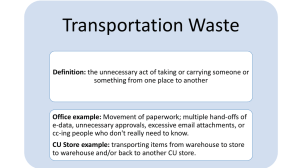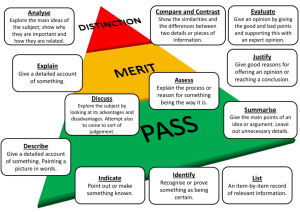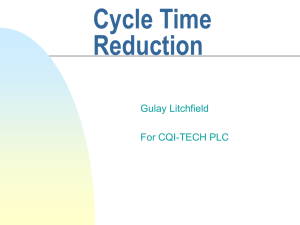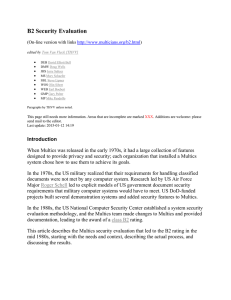INFRASTRUCTURE RISK REDUCTION Harold ”Bud” Lawson Lawson Konsult AB
advertisement
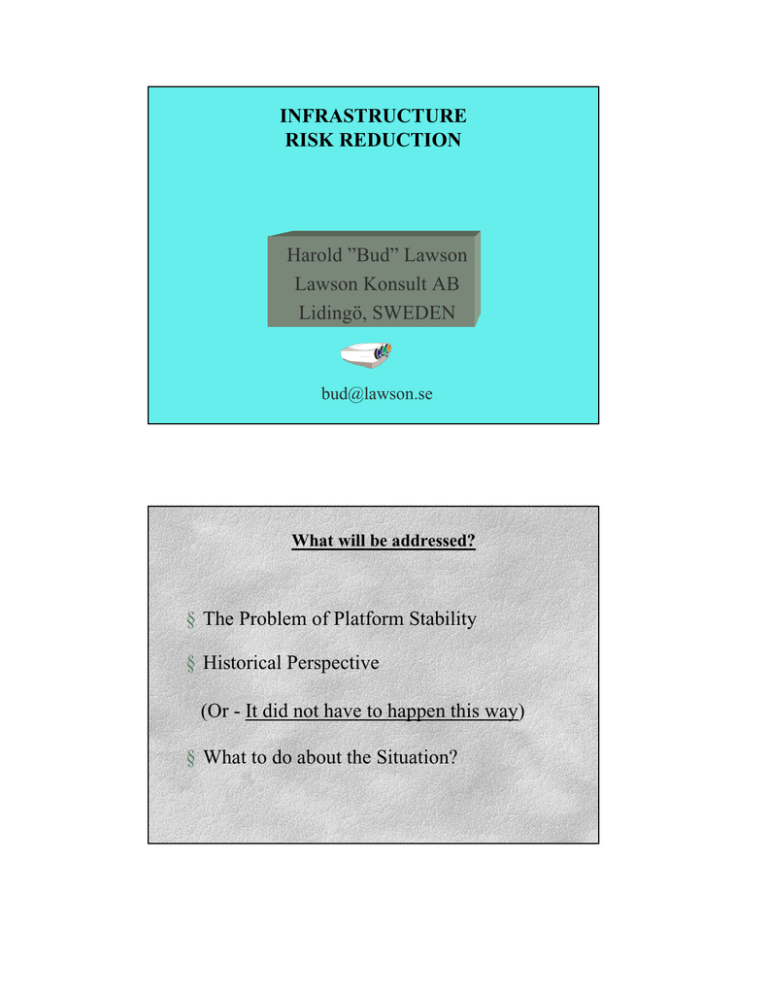
INFRASTRUCTURE RISK REDUCTION Harold ”Bud” Lawson Lawson Konsult AB Lidingö, SWEDEN bud@lawson.se What will be addressed? § The Problem of Platform Stability § Historical Perspective (Or - It did not have to happen this way) § What to do about the Situation? BACKGROUND • Today’s computer and communication systems contain significant unnecessary complexity • These complexities permeate platforms of hardware and system software components • The platforms host many complex, often critical, applications Two main sources of Unnecessary Complexity § Feature-itis - (Too much functionality) § Levelwise mapping of application functions - via programming languages, operating systems, protocols and middlewares onto poor or inappropriate platforms TRUTH IN ADVERTISEMENT us o r e ang d e ! y b lth!! a a g m r he n i u ok yo S m to Unnecessary Complexity Inside REAL DANGER of the CURRENT SITUATION Unnecessary Complexity Klipp “Catastrophé Gap” Ability to Master Complexity 1963 1999 . . . . . A quote from Intel Fellow Robert Colwell § "Users will require better dependability and security. Antilock brakes that "mostly work" or "hardly every crash" wouldn't be acceptable, but that describes general-purpose computing today. This situation arises because we do not design hardware in conjunction with software, application developers don't design software with the OS, and companies place less emphasis on the overall hardware-software system reliability than in getting to market quickly. § Ultimately the lack of system dependability could well become industry's concern because it will become society's burden." ”REMEMBER THE YORKTOWN” A Windows NT error caused the disabling of the Aegis guided missile cruiser Yorktown. The Yorktown could not perform its mission and had to be towed into port. ”This is a prime example of an otherwise well engineered system that failed due to a platform bug.” Most likely, there are many platform related failures in a variety of critical application domains that are not publicly reported. THE ESSENTIAL TRANSFORMATION Valueware Application Valueware Busyware Platform Stableware Busyware Characteristics § Complex mapping of application functions - via programming languages, operating systems, protocols, middlewares - onto poor or inappropriate platforms § Perpetuates the motivation to use low levels of programming (including C, C++ and Java) § Results in unnecessary “costs” and “risks” (especially in maintenance) § Focus on “mundane knowledge” of isolated aspects (resulting in enormous remuneration for trivialities) Stableware Characteristics § Promotes true high level programming by closing the language-machine semantic gap § System software functions provided via well defined “machine” semantics § Language and system machine semantics are standardized, verifiable, and certifiable § Stimulates competition in providing Stableware § Enables concentration on and establishes a strong market for “good” Valueware Conclusion Mainstream computing has proven to be useful -HOWEVERIt has lead to Busyware and thus is dangerous Any Salvation? Alternative architectures (have been) can be developed that (could have been) can be applied in realizing verifiable and certifiable Stableware Achieving the transform is technically feasible When will the transform occur? Most likely, it probably will only happen when one or more major catastrophe’s occur For example not being able to maintain 40 million + lines of code, a major incurable virus, and/or crashes in major systems (finance, transport, …). Far-sighted companies could plan for it now and get a jump on the market Historical Perspective (Or - It did not have to happen this way) Hardware mainstream computing devices Dominated firstly, by the IBM 360/370 family and secondly, by the Intel X86 family The Weakening of Architecture IBM 360/370 and Intel x86 Both ingenious from a circuit technology viewpoint Instruction sets source of significant complexity Made system and application software complex Widened the Semantic Gap Tipping the Balance Archit ectu Weak re Processes, Methods & Tools Heavy An Emphasis of Heavy Processes and their Evaluation Appeals to people who do not know what they are doing. Creates information overload: thus compounding the problem of unnecessary complexity. Mastery of even small portions of the complexity creates a deep feeling of satisfaction without solving the real problem. “see Dilbert Cartoon on the Process Manager” Programming languages Fundamental tools of the programming trade. Fred Brooks points out: "The transition from machine level to higher level languages led to the single biggest productivity gain ever made in software development." Therefore: It is surprising and alarming that today’s system programs, composed of megabytes of code, are constructed using low levels of programming abstraction including C, C++ and Java. Operating systems In the IBM 360/370 era, OS/360 was born. "Eighth Wonder of the World". A case a galloping complexity. Complexities arose that were beyond the comprehension of the mortals involved. Fred Brooks, manager of this effort, developed notion of the "Mythical Man Month." After inheriting OS/360 management; Watts Humphrey developed his view of the need for "Capability Maturity." An approach to ”Mess Management”. Systems Engineers a new lucrative profession was born With the altruistic goal of helping the customers solve their application problems with the new computer technology, IBM introduced Systems Engineers. Reality Systems engineers job existed because customers did not have a chance of mastering System/360 complexity. Attempts to Reduce Complexities Late 1950s and early 1960s, work of Robert Barton leads to Burroughs B5000 and B5500. Stack oriented machines provide a language friendly instruction set. Compilers for Algol and COBOL straight-forward to implement. Due to the hardware technology at that time, machine was difficult to realize and expensive. General-Purpose Microprogrammable Processors In the late 1960s and early 1970s Standard Computer Corporation MLP-900, Nanodata QM-1, Burroughs B1700, Datasaab FCPU Provide microprogramming environment for multiple instruction set emulation as well as language friendly instruction sets. Not long after the microprocessor entered the marketplace and by the late 1970s, the X86 era had begun. Again, an end to creative architectures aimed at reducing the hardware - programming language semantic gap. What About RISCs and CISCs? Late 1970s and early 1980s arguments: RISCs and CISCs Several advantages with RISC approach Bottom line, X86 (a CISC architecture) became the mainstream hardware device While better, RISCs not particularly programming language friendly Complex code generation decisions are passed up into compilers MULTICS Operating System Implemented in the PL/I programming language MULTICS, developed at MIT, had commercial life with General Electric and Honeywell Experience with MULTICS based systems indicated manageability of installations In contrast, UNIX is implemented in C and we observe concrete results of complexities in managing and operating incompatible variants of UNIX installations Improving upon the situation Lift the level of programming abstraction for all systems and application programming Require the definition of programming languages and key system functions as standardized, verifiable ”machines” Close the semantic gap between programming languages and system functions in respect to the instruction repertoires of microprocessors Effectively employ levelwise function distribution as a means of reducing total system complexity A new generation of microprocessors Introduce the general purpose microprogrammable processor as the mainstream processor work horse RISCs and CISCs firstly joined by, and eventually replaced by FIMs - (Function Integration Microprocessors) Based upon general purpose microprogram technology with multiple emulation facilities Sound basis for achieving the necessary improvements -programming language friendly instruction repertoires -functions migrated from higher levels into microcode Attempts were made to move this way earlier Why should they succeed this time? Firstly, combined hardware, system software complexity limit for current X86 technology is rapidly being reached Secondly, due to advances in circuit technology, there is no limiting hardware resource factor Thirdly, CAD tools are available to permit us to generate the hardware designs at a fraction of the cost and time Finally, FIM design is significantly simpler than the complex pipelined structures of the X86 era CONCLUSIONS § Unnecessary Complexity makes mainstream computing risky business § Improvement is technically feasible § Suppliers of platforms must take “limited” product responsibility § Standards for programming languages and platform critical functions must be well defined “as machines” that are verifiable and that can lead to certification of suppliers product The Transform from Busyware to Stableware can (and must) be made!!! A “mini-step” towards deploying FIMs was taken in the pico-Java machines An XMLstandard where parsers and interpreters are clearly defined as machines could provide a natural starting point in moving towards Stableware Any Venture Capitalists Listening!!!

